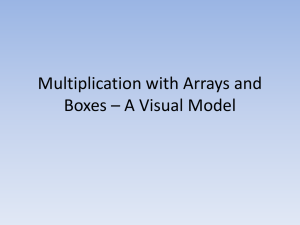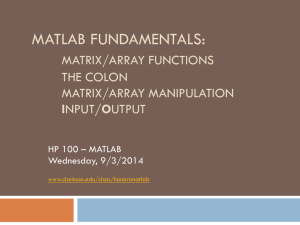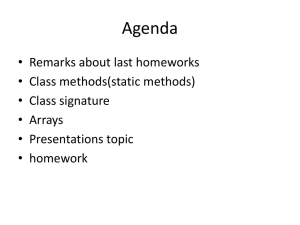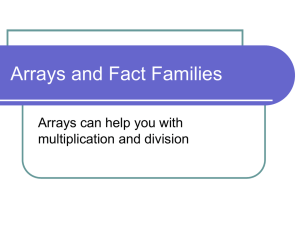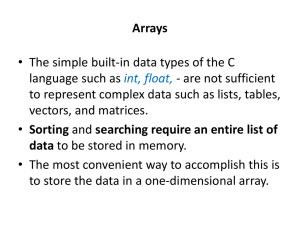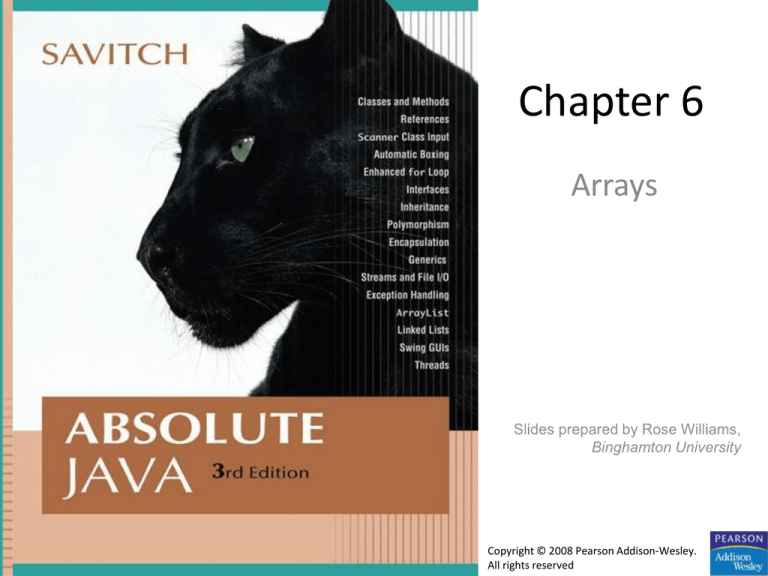
Chapter 6
Arrays
Copyright © 2008 Pearson Addison-Wesley.
All rights reserved
Introduction to Arrays
• An array is a data structure used to process a
collection of data that is all of the same type
– An array behaves like a numbered list of variables with a
uniform naming mechanism
– It has a part that does not change: the name of the array
– It has a part that can change: an integer in square brackets
– For example, given five scores:
score[0], score[1], score[2], score[3], score[4]
Copyright © 2008 Pearson Addison-Wesley. All rights reserved
6-2
Creating and Accessing Arrays
• An array that behaves like this collection of variables, all of
type double, can be created using one statement as follows:
double[] score = new double[5];
• Or using two statements:
double[] score;
score = new double[5];
– The first statement declares the variable score to be of the array
type double[]
– The second statement creates an array with five numbered variables
of type double and makes the variable score a name for the array
Copyright © 2008 Pearson Addison-Wesley. All rights reserved
6-3
Creating and Accessing Arrays
• The individual variables that together make up the
array are called indexed variables
– They can also be called subscripted variables or elements
of the array
– The number in square brackets is called an index or
subscript
– In Java, indices must be numbered starting with 0, and
nothing else
score[0], score[1], score[2], score[3], score[4]
Copyright © 2008 Pearson Addison-Wesley. All rights reserved
6-4
Creating and Accessing Arrays
• The number of indexed variables in an array is called
the length or size of the array
• When an array is created, the length of the array is
given in square brackets after the array type
• The indexed variables are then numbered starting
with 0, and ending with the integer that is one less
than the length of the array
score[0], score[1], score[2], score[3], score[4]
Copyright © 2008 Pearson Addison-Wesley. All rights reserved
6-5
Creating and Accessing Arrays
double[] score = new double[5];
• A variable may be used in place of the integer (i.e., in place of
the integer 5 above)
– The value of this variable can then be read from the keyboard
– This enables the size of the array to be determined when the program
is run
double[] score = new double[count];
• An array can have indexed variables of any type, including any
class type
• All of the indexed variables in a single array must be of the
same type, called the base type of the array
Copyright © 2008 Pearson Addison-Wesley. All rights reserved
6-6
Declaring and Creating an Array
• An array is declared and created in almost the same
way that objects are declared and created:
BaseType[] ArrayName = new BaseType[size];
– The size may be given as an expression that evaluates
to a nonnegative integer, for example, an int variable
char[] line = new char[80];
double[] reading = new double[count];
Person[] specimen = new Person[100];
Copyright © 2008 Pearson Addison-Wesley. All rights reserved
6-7
Referring to Arrays and Array Elements
• Each array element can be used just like any other single
variable by referring to it using an indexed expression:
score[0]
• The array itself (i.e., the entire collection of indexed variables)
can be referred to using the array name (without any square
brackets): score
• An array index can be computed when a program is run
– It may be represented by a variable: score[index]
– It may be represented by an expression that evaluates to a suitable
integer: score[next + 1]
Note:
Demo ArrayOfScores
Copyright © 2008 Pearson Addison-Wesley. All rights reserved
6-8
Using the score Array in a Program
• The for loop is ideally suited for performing array
manipulations:
for (index = 0; index < 5; index++)
System.out.println(score[index] +
" differs from max by " +
(max-score[index]) );
Copyright © 2008 Pearson Addison-Wesley. All rights reserved
6-9
Three Ways to Use Square Brackets [] with an
Array Name
• Square brackets can be used to create a type name:
double[] score;
• Square brackets can be used with an integer value as
part of the special syntax Java uses to create a new
array:
score = new double[5];
• Square brackets can be used to name an indexed
variable of an array:
max = score[0];
Copyright © 2008 Pearson Addison-Wesley. All rights reserved
6-10
The length Instance Variable
• An array is considered to be an object
• Since other objects can have instance variables, so can
arrays
• Every array has exactly one instance variable named
length
– When an array is created, the instance variable length is
automatically set equal to its size
– The value of length cannot be changed (other than by
creating an entirely new array with new)
double[] score = new double[5];
– Given score above, score.length has a value of 5
Note: See ArrayOfScores2 for the use of score.length
Copyright © 2008 Pearson Addison-Wesley. All rights reserved
6-11
Pitfall: Array Index Out of Bounds
• Array indices always start with 0, and always end with
the integer that is one less than the size of the array
– The most common programming error made when using arrays
is attempting to use a nonexistent array index
• When an index expression evaluates to some value
other than those allowed by the array declaration, the
index is said to be out of bounds
– An out of bounds index will cause a program to terminate with
a run-time error message
– Array indices get out of bounds most commonly at the first or
last iteration of a loop that processes the array: Be sure to test
for this!
Copyright © 2008 Pearson Addison-Wesley. All rights reserved
6-12
Suppose we expect the elements of the array a to be ordered so that
a[0] ≤ a[1] ≤ a[2] ≤ ...
However, to be safe we want our program to test the array and issue
a warning in case it turns out that some elements are out of order.
The following code is supposed to output such a warning, but it
contains a bug; what is the bug?
double[] a = new double[10];
<some code to fill the array a goes here>
for ( int i = 0; i < a.length; i++ )
if ( a[i] > a[i + 1] )
System.out.println( “Array elements “ + i + “ and “ +
( i + 1 ) + “ are out of order.” );
6-13
Initializing Arrays
• An array can be initialized when it is declared
– Values for the indexed variables are enclosed in braces,
and separated by commas
– The array size is automatically set to the number of values
in the braces
int[] age = {2, 12, 1};
– Given age above, age.length has a value of 3
Copyright © 2008 Pearson Addison-Wesley. All rights reserved
6-14
Initializing Arrays
• Another way of initializing an array is by using a for loop
double[] reading = new double[100];
int index;
for (index = 0;
index < reading.length; index++)
reading[index] = 42.0;
• If the elements of an array are not initialized explicitly, they
will automatically be initialized to the default value for their
base type
Copyright © 2008 Pearson Addison-Wesley. All rights reserved
6-15
Pitfall: An Array of Characters Is Not a String
• An array of characters is conceptually a list of
characters, and so is conceptually like a string
• However, an array of characters is not an object
of the class String
char[] a = {'A', 'B', 'C'};
String s = a; //Illegal!
• An array of characters can be converted to an
object of type String, however
Copyright © 2008 Pearson Addison-Wesley. All rights reserved
6-16
Pitfall: An Array of Characters Is Not a String
• The class String has a constructor that has a single
parameter of type char[]
String s = new String(a);
– The object s will have the same sequence of characters as
the entire array a ("ABC"), but is an independent copy
• Another String constructor uses a subrange of a
character array instead
String s2 = new String(a,0,2);
– Given a as before, the new string object is "AB"
Copyright © 2008 Pearson Addison-Wesley. All rights reserved
6-17
Pitfall: An Array of Characters Is Not a String
• An array of characters does have some things
in common with String objects
– For example, an array of characters can be output
using println
System.out.println(a);
– Given a as before, this would produce the output
ABC
Copyright © 2008 Pearson Addison-Wesley. All rights reserved
6-18
Arrays and References
• Like class types, a variable of an array type
holds a reference
– Arrays are objects
– A variable of an array type holds the address of
where the array object is stored in memory
– Array types are (usually) considered to be class
types
Copyright © 2008 Pearson Addison-Wesley. All rights reserved
6-19
Arrays are Objects
• An array can be viewed as a collection of indexed variables
• An array can also be viewed as a single item whose value is a
collection of values of a base type
– An array variable names the array as a single item
double[] a;
– A new expression creates an array object and stores the object in
memory
new double[10]
– An assignment statement places a reference to the memory address of
an array object in the array variable
a = new double[10];
Copyright © 2008 Pearson Addison-Wesley. All rights reserved
6-20
Arrays Are Objects
• The previous steps can be combined into one statement
double[] a = new double[10];
• Note that the new expression that creates an array
invokes a constructor that uses a nonstandard syntax
• Not also that as a result of the assignment statement
above, a contains a single value: a memory address or
reference
• Since an array is a reference type, the behavior of arrays
with respect to assignment (=), equality testing (==),
and parameter passing are the same as that described
for classes
Copyright © 2008 Pearson Addison-Wesley. All rights reserved
6-21
Pitfall: Arrays with a Class Base Type
• The base type of an array can be a class type
Date[] holidayList = new Date[20];
• The above example creates 20 indexed variables of
type Date
– It does not create 20 objects of the class Date
– Each of these indexed variables are automatically
initialized to null
– Any attempt to reference any them at this point would
result in a "null pointer exception" error message
Copyright © 2008 Pearson Addison-Wesley. All rights reserved
6-22
Pitfall: Arrays with a Class Base Type
• Like any other object, each of the indexed variables requires a
separate invocation of a constructor using new (singly, or
perhaps using a for loop) to create an object to reference
holidayList[0] = new Date();
. . .
holidayList[19] = new Date();
OR
for (int i = 0; i < holidayList.length; i++)
holidayList[i] = new Date();
• Each of the indexed variables can now be referenced since
each holds the memory address of a Date object
Copyright © 2008 Pearson Addison-Wesley. All rights reserved
6-23
Array Parameters
• Both array indexed variables and entire arrays
can be used as arguments to methods
– An indexed variable can be an argument to a
method in exactly the same way that any variable
of the array base type can be an argument
Copyright © 2008 Pearson Addison-Wesley. All rights reserved
6-24
Array Parameters
double n = 0.0;
double[] a = new double[10];//all elements
//are initialized to 0.0
int i = 3;
• Given myMethod which takes one argument of type
double, then all of the following are legal:
myMethod(n);//n evaluates to 0.0
myMethod(a[3]);//a[3] evaluates to 0.0
myMethod(a[i]);//i evaluates to 3,
//a[3] evaluates to 0.0
Copyright © 2008 Pearson Addison-Wesley. All rights reserved
6-25
Array Parameters
• An argument to a method may be an entire array
• Array arguments behave like objects of a class
– Therefore, a method can change the values stored in the
indexed variables of an array argument
• A method with an array parameter must specify the
base type of the array only
BaseType[]
– It does not specify the length of the array
Copyright © 2008 Pearson Addison-Wesley. All rights reserved
6-26
Array Parameters
• The following method, doubleElements, specifies an
array of double as its single argument:
public class SampleClass
{
public static void doubleElements(double[] a)
{
int i;
for (i = 0; i < a.length; i++)
a[i] = a[i]*2;
. . .
}
. . .
}
Copyright © 2008 Pearson Addison-Wesley. All rights reserved
6-27
Array Parameters
• Arrays of double may be defined as follows:
double[] a = new double[10];
double[] b = new double[30];
• Given the arrays above, the method doubleElements
from class SampleClass can be invoked as follows:
SampleClass.doubleElements(a);
SampleClass.doubleElements(b);
– Note that no square brackets are used when an entire array is
given as an argument
– Note also that a method that specifies an array for a parameter
can take an array of any length as an argument
Copyright © 2008 Pearson Addison-Wesley. All rights reserved
6-28
public class SampleClass {
public static void doubleElements(double[] a){
int i;
for (i = 0; i < a.length; i++)
a[i] = a[i]*2;
}
public static void main(String[] args) {
double[] score = {3.5, 2.5, 10};
double[] number = {100, 200, 45, 23.5, 35.8, 12, 56.9};
int index;
System.out.println(“Original score array:” );
for (index = 0; index < score.length; index++)
System.out.println(score[index] );
System.out.println(“Original number array:”);
for (index = 0; index < number.length; index++)
System.out.println(number[index] );
doubleElements (score);
doubleElements (number);
System.out.println(“new score array: “);
for (index = 0; index < score.length; index++)
System.out.println(score[index] );
System.out.println(“new number array: “);
for (index = 0; index < number.length; index++)
System.out.println(number[index] );
}//end
6-29 main
}//end class
public class AClass
{
public static void listChars( char[] a )
{
int i;
for ( i = 0; i < a.length; i++; )
System.out.println( a[i] + “ “ );
}
public static void zeroAll( int[] anArray )
{
int i;
for ( i = 0; i < anArray.length; i++ )
anArray[i] = 0;
}
...
}
...
char[] c = new char[10];
int[] a = new int[10];
int[] b = new int[50];
...
AClass.listChars( c );
AClass.zeroAll( a );
AClass.zeroAll( b );
6-30
Notice that arrays a
and b have different
lengths
Pitfall: Use of = and == with Arrays
• Because an array variable contains the memory
address of the array it names, the assignment
operator (=) only copies this memory address
– It does not copy the values of each indexed variable
– Using the assignment operator will make two array
variables be different names for the same array
b = a;
– The memory address in a is now the same as the
memory address in b: They reference the same array
Copyright © 2008 Pearson Addison-Wesley. All rights reserved
6-31
Pitfall: Use of = and == with Arrays
• A for loop is usually used to make two
different arrays have the same values in each
indexed position:
int i;
for (i = 0;
(i < a.length)
b[i] = a[i];
&& (i < b.length); i++)
– Note that the above code will not make b an exact
copy of a, unless a and b have the same length
Copyright © 2008 Pearson Addison-Wesley. All rights reserved
6-32
Pitfall: Use of = and == with Arrays
• For the same reason, the equality operator (==)
only tests two arrays to see if they are stored in
the same location in the computer's memory
– It does not test two arrays to see if they contain the
same values
(a == b)
– The result of the above boolean expression will be
true if a and b share the same memory address
(and, therefore, reference the same array), and
false otherwise
Copyright © 2008 Pearson Addison-Wesley. All rights reserved
6-33
Pitfall: Use of = and == with Arrays
• In the same way that an equals method
can be defined for a class, an
equalsArray method can be defined
for a type of array
– This is how two arrays must be tested to see
if they contain the same elements
– The following method tests two integer
arrays to see if they contain the same integer
values
Copyright © 2008 Pearson Addison-Wesley. All rights reserved
6-34
Pitfall: Use of = and == with Arrays
public static boolean equalsArray(int[] a, int[] b)
{
if (a.length != b.length) return false;
else
{
int i = 0;
while (i < a.length)
{
if (a[i] != b[i])
return false;
i++;
}
}
return true;
}
Copyright © 2008 Pearson Addison-Wesley. All rights reserved
6-35
• DifferentEquals
6-36
Methods That Return an Array
• In Java, a method may also return an array
– The return type is specified in the same way that an array
parameter is specified
public static int[]
incrementArray(int[] a, int increment)
{
int[] temp = new int[a.length];
int i;
for (i = 0; i < a.length; i++)
temp[i] = a[i] + increment;
return temp;
}
Copyright © 2008 Pearson Addison-Wesley. All rights reserved
6-37
public class SampleClass1 {
public static int[] incrementArray(int[] a, int increment){
int[] temp = new int[a.length];
int i;
for (i = 0; i < a.length; i++)
temp[i] = a[i] + increment;
return temp;
}
public static void main(String[] args) {
int[] score = {3, 2, 10};
int[] number = {100, 200, 45, 2, 35, 12, 56};
int index;
System.out.println(“Original score array:” );
for (index = 0; index < score.length; index++)
System.out.println(score[index] );
System.out.println(“Original number array:”);
for (index = 0; index < number.length; index++)
System.out.println(number[index] );
int[] newScore = incrementArray (score,10);
int[] newNumber=incrementArray (number,100);
System.out.println(“new score array: “);
for (index = 0; index < score.length; index++)
System.out.println(score[index] );
6-38
System.out.println(“new number array: “);
for (index = 0; index < number.length; index++)
System.out.println(number[index] );
Partially Filled Arrays
• The exact size needed for an array is not always
known when a program is written, or it may vary
from one run of the program to another
• A common way to handle this is to declare the array
to be of the largest size that the program could
possibly need
• Care must then be taken to keep track of how much
of the array is actually used
– An indexed variable that has not been given a meaningful
value must never be referenced
Copyright © 2008 Pearson Addison-Wesley. All rights reserved
6-39
Partially Filled Arrays
• A variable can be used to keep track of how
many elements are currently stored in an array
– For example, given the variable count, the elements
of the array someArray will range from positions
someArray[0] through someArray[count –
1]
– Note that the variable count will be used to process
the partially filled array instead of
someArray.length
– Note also that this variable (count) must be an
argument to any method that manipulates the
partially filled array
Copyright © 2008 Pearson Addison-Wesley. All rights reserved
6-40
Partially Filled Arrays
• Show program GolfScores (note the use of
sentinel values)
• Show class PartiallyFilledArray
• Show program GolfScoresVersion2 (demo for
PartiallyFilledArray)
6-41
Privacy Leaks with Array Instance Variables
• If an accessor method does return the contents of an
array, special care must be taken
– Just as when an accessor returns a reference to any private
object
public double[] getArray()
{
return anArray;//BAD!
}
– The example above will result in a privacy leak
Copyright © 2008 Pearson Addison-Wesley. All rights reserved
6-42
Privacy Leaks with Array Instance Variables
• The previous accessor method would simply return a
reference to the array anArray itself
• Instead, an accessor method should return a reference
to a deep copy of the private array object
– Below, both a and count are instance variables of the class
containing the getArray method
public double[] getArray()
{
double[] temp = new double[count];
for (int i = 0; i < count; i++)
temp[i] = a[i];
return temp
}
Copyright © 2008 Pearson Addison-Wesley. All rights reserved
6-43
Privacy Leaks with Array Instance Variables
• If a private instance variable is an array that has a class as its
base type, then copies must be made of each class object in
the array when the array is copied:
public ClassType[] getArray()
{
ClassType[] temp = new ClassType[count];
for (int i = 0; i < count; i++)
temp[i] = new ClassType(someArray[i]);
return temp;
}
Note: see ToyExample
Copyright © 2008 Pearson Addison-Wesley. All rights reserved
6-44
Sorting an Array
• A sort method takes in an array parameter a, and
rearranges the elements in a, so that after the
method call is finished, the elements of a are sorted
in ascending order
• A selection sort accomplishes this by using the
following algorithm:
for (int index = 0; index < count; index++)
Place the indexth smallest element in
a[index]
Copyright © 2008 Pearson Addison-Wesley. All rights reserved
6-45
Selection Sort (Part 1 of 2)
Copyright © 2008 Pearson Addison-Wesley. All rights reserved
6-46
Selection Sort (Part 2 of 2)
Copyright © 2008 Pearson Addison-Wesley. All rights reserved
6-47
SelectionSort Class (Part 1 of 5)
public class SelectionSort
{
/**
Precondition: count <= a.length;
The first count indexed variables have
values.
Action: Sorts a so that a[0] <= a[1] <=
... <= a[count - 1].
*/
Copyright © 2008 Pearson Addison-Wesley. All rights reserved
6-48
SelectionSort Class (Part 2 of 5)
public static void sort(double[] a, int count)
{
int index, indexOfNextSmallest;
for (index = 0; index < count - 1; index++)
{
indexOfNextSmallest =
indexOfSmallest(index, a, count);
interchange(index, indexOfNextSmallest, a);
}
}
Copyright © 2008 Pearson Addison-Wesley. All rights reserved
6-49
SelectionSort Class (Part 3 of 5)
/**
Returns the index of the smallest value among
a[startIndex], a[startIndex+1], ... a[count - 1]
*/
private static int indexOfSmallest(int
startIndex, double[] a, int count)
{
double min = a[startIndex];
int indexOfMin = startIndex;
int index;
Copyright © 2008 Pearson Addison-Wesley. All rights reserved
6-50
SelectionSort Class (Part 4 of 5)
for (index = startIndex + 1;
index < count; index++)
if (a[index] < min)
{
min = a[index];
indexOfMin = index;
}
return indexOfMin;
}
Copyright © 2008 Pearson Addison-Wesley. All rights reserved
6-51
SelectionSort Class (Part 5 of 5)
/* Precondition: i and j are legal indices for
the array a.
Postcondition: Values of a[i] and a[j] have
been interchanged.
*/
private static void interchange(int i, int j,
double[] a)
{
double temp;
temp = a[i];
a[i] = a[j];
a[j] = temp; //original value of a[i]
}
}
Note: see SelectionSort and SelectionSortDemo
Copyright © 2008 Pearson Addison-Wesley. All rights reserved
6-52
Enumerated Types
• Starting with version 5.0, Java permits enumerated types
– An enumerated type is a type in which all the values are given in a
(typically) short list
• The definition of an enumerated type is normally placed
outside of all methods in the same place that named
constants are defined:
enum TypeName {VALUE_1, VALUE_2, …, VALUE_N};
– Note that a value of an enumerated type is a kind of named constant
and so, by convention, is spelled with all uppercase letters
– As with any other type, variables can be declared of an enumerated
type
Copyright © 2008 Pearson Addison-Wesley. All rights reserved
6-53
Enumerated Types Example
• Given the following definition of an enumerated
type:
enum WorkDay {MONDAY, TUESDAY,
WEDNESDAY, THURSDAY, FRIDAY};
• A variable of this type can be declared as follows:
WorkDay meetingDay, availableDay;
• The value of a variable of this type can be set to
one of the values listed in the definition of the
type, or else to the special value null:
meetingDay = WorkDay.THURSDAY;
availableDay = null;
Copyright © 2008 Pearson Addison-Wesley. All rights reserved
6-54
Enumerated Types Usage
• Just like other types, variable of this type can be
declared and initialized at the same time:
WorkDay meetingDay = WorkDay.THURSDAY;
– Note that the value of an enumerated type must be prefaced
with the name of the type
• The value of a variable or constant of an enumerated
type can be output using println
– The code:
System.out.println(meetingDay);
– Will produce the following output:
THURSDAY
– As will the code:
System.out.println(WorkDay.THURSDAY);
– Note that the type name WorkDay is not output
Copyright © 2008 Pearson Addison-Wesley. All rights reserved
6-55
Enumerated Types Usage
• Although they may look like String values, values of
an enumerated type are not String values
• However, they can be used for tasks which could be
done by String values and, in some cases, work better
– Using a String variable allows the possibility of setting the
variable to a nonsense value
– Using an enumerated type variable constrains the possible
values for that variable
– An error message will result if an attempt is made to give an
enumerated type variable a value that is not defined for its type
Copyright © 2008 Pearson Addison-Wesley. All rights reserved
6-56
Enumerated Types Usage
• Two variables or constants of an enumerated type
can be compared using the equals method or the
== operator
• However, the == operator has a nicer syntax
if (meetingDay == availableDay)
System.out.println("Meeting will be on
schedule.");
if (meetingDay == WorkDay.THURSDAY)
System.out.println("Long weekend!);
Copyright © 2008 Pearson Addison-Wesley. All rights reserved
6-57
An Enumerated Type
Copyright © 2008 Pearson Addison-Wesley. All rights reserved
6-58
Some Methods Included with Every Enumerated
Type (Part 1 of 3)
Copyright © 2008 Pearson Addison-Wesley. All rights reserved
6-59
Some Methods Included with Every Enumerated
Type (Part 2 of 3)
Copyright © 2008 Pearson Addison-Wesley. All rights reserved
6-60
Some Methods Included with Every Enumerated
Type (Part 3 of 3)
Copyright © 2008 Pearson Addison-Wesley. All rights reserved
6-61
The values Method
• To get the full potential from an enumerated type, it is often
necessary to cycle through all the values of the type
• Every enumerated type is automatically provided with the
static method values() which provides this ability
– It returns an array whose elements are the values of the enumerated
type given in the order in which the elements are listed in the
definition of the enumerated type
– The base type of the array that is returned is the enumerated type
Copyright © 2008 Pearson Addison-Wesley. All rights reserved
6-62
The Method values (Part 1 of 2)
Copyright © 2008 Pearson Addison-Wesley. All rights reserved
6-63
The Method values (Part 2 of 2)
Copyright © 2008 Pearson Addison-Wesley. All rights reserved
6-64
Programming Tip: Enumerated Types in
switch Statements
• Enumerated types can be used to control a switch
statement
– The switch control expression uses a variable of an enumerated
type
– Case labels are the unqualified values of the same enumerated type
• The enumerated type control variable is set by using the static
method valueOf to convert an input string to a value of the
enumerated type
– The input string must contain all upper case letters, or be converted to
all upper case letters using the toUpperCase method
Copyright © 2008 Pearson Addison-Wesley. All rights reserved
6-65
Enumerated Type in a switch Statement (Part
1 of 3)
Copyright © 2008 Pearson Addison-Wesley. All rights reserved
6-66
Enumerated Type in a switch Statement (Part
2 of 3)
Copyright © 2008 Pearson Addison-Wesley. All rights reserved
6-67
Enumerated Type in a switch Statement (Part
3 of 3)
Copyright © 2008 Pearson Addison-Wesley. All rights reserved
6-68
The following programs show the use of Method
values and for each loop
• ForEachEnumDemo
• ForEachEnumDemo2
6-69
Multidimensional Arrays
• It is sometimes useful to have an array with more
than one index
• Multidimensional arrays are declared and created in
basically the same way as one-dimensional arrays
– You simply use as many square brackets as there are
indices
– Each index must be enclosed in its own brackets
double[][]table = new double[100][10];
int[][][] figure = new int[10][20][30];
Person[][] = new Person[10][100];
Copyright © 2008 Pearson Addison-Wesley. All rights reserved
6-70
One dimensional Array
• double[] b = {42.0, 42.0, 42.0, 42.0, 42.0};
• double[] b = new double[5];
for (int i = 0; i < b.length; i++)
b[i] = 42.0;
• for (int i = 0; i < b.length; i++)
System.out.println( b[i]);
Copyright © 2008 Pearson Addison-Wesley. All rights reserved
6-71
Two dimensional Array
• double[][] b = {{42.0, 42.0, 42.0, 42.0, 42.0},
{42.0, 42.0, 42.0, 42.0, 42.0},
{42.0, 42.0, 42.0, 42.0, 42.0} };
• double[][] b = new double[3][5];
for (int i = 0; i < b.length; i++)
for (int j = 0; j < b[i].length; j++)
b[i][j] = 42;
Copyright © 2008 Pearson Addison-Wesley. All rights reserved
6-72
Two dimensional Array
• for (int i = 0; i < b.length; i++)
{
for (int j = 0; j < b[i].length; j++)
{
System.out.println( b[i][j]);
}
}
Copyright © 2008 Pearson Addison-Wesley. All rights reserved
6-73
Ragged 2D Array
• double[][] b = { {1, 3, 5},
{35, 26, 10, 5},
{42.0, 42.0}
};
• for (int i = 0; i < b.length; i++)
for (int j = 0; j < b[i].length; j++)
System.out.println( b[i][j] );
Copyright © 2008 Pearson Addison-Wesley. All rights reserved
6-74
Ragged 2D Array
double [][] b;
b = new double[3][];
b[0] = new double[3];
b[1] = new double[4];
b[2] = new double[2];
for (int i = 0; i < b.length; i++)
for (int j = 0; j < b[i].length; j++)
b[i][j] = 42;
Copyright © 2008 Pearson Addison-Wesley. All rights reserved
6-75
Multidimensional Arrays
• Multidimensional arrays may have any number of
indices, but perhaps the most common number is
two
– Two-dimensional array can be visualized as a twodimensional display with the first index giving the row, and
the second index giving the column
char[][] a = new char[5][12];
– Note that, like a one-dimensional array, each element of a
multidimensional array is just a variable of the base type
(in this case, char)
Copyright © 2008 Pearson Addison-Wesley. All rights reserved
6-76
Multidimensional Arrays
• In Java, a two-dimensional array, such as a, is
actually an array of arrays
– The array a contains a reference to a one-dimensional
array of size 5 with a base type of char[]
– Each indexed variable (a[0], a[1], etc.) contains a
reference to a one-dimensional array of size 12, also with a
base type of char[]
• A three-dimensional array is an array of arrays of
arrays, and so forth for higher dimensions
Copyright © 2008 Pearson Addison-Wesley. All rights reserved
6-77
Two-Dimensional Array as an Array of Arrays (Part 1
of 2)
Copyright © 2008 Pearson Addison-Wesley. All rights reserved
6-78
Two-Dimensional Array as an Array of Arrays (Part 2
of 2)
Copyright © 2008 Pearson Addison-Wesley. All rights reserved
6-79
Using the length Instance Variable
char[][] page = new char[30][100];
• The instance variable length does not give the total number
of indexed variables in a two-dimensional array
– Because a two-dimensional array is actually an array of arrays, the
instance variable length gives the number of first indices (or "rows")
in the array
• page.length is equal to 30
– For the same reason, the number of second indices (or "columns") for
a given "row" is given by referencing length for that "row" variable
• page[0].length is equal to 100
Copyright © 2008 Pearson Addison-Wesley. All rights reserved
6-80
Using the length Instance Variable
• The following program demonstrates how a
nested for loop can be used to process a twodimensional array
– Note how each length instance variable is used
int row, column;
for (row = 0; row < page.length; row++)
for (column = 0; column < page[row].length;
column++)
page[row][column] = 'Z';
Copyright © 2008 Pearson Addison-Wesley. All rights reserved
6-81
Ragged Arrays
• Each row in a two-dimensional array need not
have the same number of elements
– Different rows can have different numbers of
columns
• An array that has a different number of
elements per row it is called a ragged array
Copyright © 2008 Pearson Addison-Wesley. All rights reserved
6-82
Ragged Arrays
double[][] a = new double[3][5];
• The above line is equivalent to the following:
double [][] a;
a = new double[3][]; //Note below
a[0] = new double[5];
a[1] = new double[5];
a[2] = new double[5];
– Note that the second line makes a the name of an array with room for
3 entries, each of which can be an array of doubles that can be of
any length
– The next 3 lines each create an array of doubles of size 5
Copyright © 2008 Pearson Addison-Wesley. All rights reserved
6-83
Ragged Arrays
double [][] a;
a = new double[3][];
• Since the above line does not specify the size of
a[0], a[1], or a[2], each could be made a
different size instead:
a[0] = new double[5];
a[1] = new double[10];
a[2] = new double[4];
Copyright © 2008 Pearson Addison-Wesley. All rights reserved
6-84
Multidimensional Array Parameters and
Returned Values
• Methods may have multidimensional array
parameters
– They are specified in a way similar to one-dimensional
arrays
– They use the same number of sets of square brackets as
they have dimensions
public void myMethod(int[][] a)
{ . . . }
– The parameter a is a two-dimensional array
Copyright © 2008 Pearson Addison-Wesley. All rights reserved
6-85
Multidimensional Array Parameters and
Returned Values
• Methods may have a multidimensional array
type as their return type
– They use the same kind of type specification as for
a multidimensional array parameter
public double[][] aMethod()
{ . . . }
– The method aMethod returns an array of
double
Copyright © 2008 Pearson Addison-Wesley. All rights reserved
6-86
A Grade Book Class
• As an example of using arrays in a program, a class
GradeBook is used to process quiz scores
• Objects of this class have three instance variables
– grade: a two-dimensional array that records the grade of
each student on each quiz
– studentAverage: an array used to record the average
quiz score for each student
– quizAverage: an array used to record the average
score for each quiz
Copyright © 2008 Pearson Addison-Wesley. All rights reserved
6-87
A Grade Book Class
• The score that student 1 received on quiz number 3
is recorded in grade[0][2]
• The average quiz grade for student 2 is recorded in
studentAverage[1]
• The average score for quiz 3 is recorded in
quizAverage[2]
• Note the relationship between the three arrays
Copyright © 2008 Pearson Addison-Wesley. All rights reserved
6-88
The Two-Dimensional Array grade
Copyright © 2008 Pearson Addison-Wesley. All rights reserved
6-89
Example of Two-Dimensional Array
• GradeBook
• GradeBookDemo
Copyright © 2008 Pearson Addison-Wesley. All rights reserved
6-90
public class GradeBook
{
private int numberOfStudents; // Same as studentAverage.length.
private int numberOfQuizzes; // Same as quizeAverage.length.
private int[][] grade; //numberOfStudents rows and numberOfQuizzes columns.
private double[] studentAverage;
private double[] quizAverage;
public GradeBook(int[][] a)
{
if (a.length == 0 || a[0].length == 0)
{
System.out.println("Empty grade records. Aborting.");
System.exit(0);
}
numberOfStudents = a.length;
numberOfQuizzes = a[0].length;
fillGrade(a);
fillStudentAverage( );
fillQuizAverage( );
}
5-91
public GradeBook(GradeBook book)
{
numberOfStudents = book.numberOfStudents;
numberOfQuizzes = book.numberOfQuizzes;
fillGrade(book.grade);
fillStudentAverage( );
fillQuizAverage( );
}
5-92
public GradeBook( )
{
Scanner keyboard = new Scanner(System.in);
System.out.println("Enter number of students:");
numberOfStudents = keyboard.nextInt( );
System.out.println("Enter number of quizzes:");
numberOfQuizzes = keyboard.nextInt( );
grade = new int [numberOfStudents][numberOfQuizzes];
5-93
for (int studentNumber = 1; studentNumber <= numberOfStudents; studentNumber++)
for (int quizNumber = 1; quizNumber <= numberOfQuizzes; quizNumber++)
{
System.out.println("Enter score for student number " + studentNumber);
System.out.println("on quiz number " + quizNumber);
grade[studentNumber - 1][quizNumber - 1] = keyboard.nextInt( );
}
fillStudentAverage( );
fillQuizAverage( );
}
5-94
private void fillGrade(int [][] a)
{
grade = new int[numberOfStudents][numberOfQuizzes];
for (int studentNumber = 1;
studentNumber <= numberOfStudents; studentNumber++)
{
for (int quizNumber = 1;
quizNumber <= numberOfQuizzes; quizNumber++)
grade[studentNumber-1][quizNumber-1] =
a[studentNumber-1][quizNumber-1];
}
}
Copyright © 2008 Pearson Addison-Wesley. All rights reserved
6-95
private void fillStudentAverage( )
{
studentAverage = new double[numberOfStudents];
for (int studentNumber = 1;
studentNumber <= numberOfStudents; studentNumber++)
{
double sum = 0;
for (int quizNumber = 1;
quizNumber <= numberOfQuizzes; quizNumber++)
sum = sum + grade[studentNumber - 1][quizNumber - 1];
studentAverage[studentNumber - 1] = sum / numberOfQuizzes;
}
}
Copyright © 2008 Pearson Addison-Wesley. All rights reserved
6-96
private void fillQuizAverage( )
{
quizAverage = new double[numberOfQuizzes];
for (int quizNumber = 1; quizNumber <= numberOfQuizzes; quizNumber++)
{
double sum = 0;
for (int studentNumber = 1;
studentNumber <= numberOfStudents; studentNumber++)
sum = sum + grade[studentNumber - 1][quizNumber - 1];
quizAverage[quizNumber - 1] = sum / numberOfStudents;
}
}
Copyright © 2008 Pearson Addison-Wesley. All rights reserved
6-97
public void display( )
{
for (int studentNumber = 1;
studentNumber <= numberOfStudents; studentNumber++)
{
System.out.print("Student " + studentNumber + " Quizzes: ");
for (int quizNumber = 1;
quizNumber <= numberOfQuizzes; quizNumber++)
System.out.print(grade[studentNumber - 1][quizNumber - 1] + " ");
System.out.println(" Ave = " + studentAverage[studentNumber - 1] );
}
System.out.println("Quiz averages: ");
for (int quizNumber = 1; quizNumber <= numberOfQuizzes; quizNumber++)
System.out.print("Quiz " + quizNumber
+ " Ave = " + quizAverage[quizNumber - 1] + " ");
System.out.println( );
}
Copyright © 2008 Pearson Addison-Wesley. All rights reserved
6-98
public class GradeBookDemo
{
public static void main(String[] args)
{
GradeBook book = new GradeBook( );
book.display( );
}
}
Copyright © 2008 Pearson Addison-Wesley. All rights reserved
6-99

